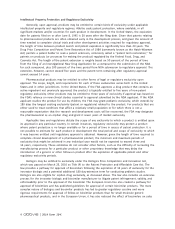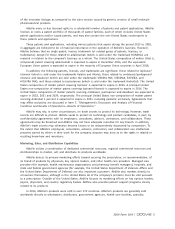AbbVie 2014 Annual Report Download - page 20
Download and view the complete annual report
Please find page 20 of the 2014 AbbVie annual report below. You can navigate through the pages in the report by either clicking on the pages listed below, or by using the keyword search tool below to find specific information within the annual report.
13NOV201221352027
Any significant event that adversely affects HUMIRA revenues could have a material and negative
impact on AbbVie’s results of operations and cash flows.
HUMIRA accounted for approximately 63 percent of AbbVie’s total net sales in 2014. Any significant
event that adversely affects HUMIRA’s revenues could have a material adverse impact on AbbVie’s results of
operations and cash flows. These events could include loss of patent protection for HUMIRA, the approval
of biosimilars of HUMIRA, the discovery of previously unknown side effects or impaired efficacy, increased
competition from the introduction of new, more effective or less expensive treatments, and discontinuation
or removal from the market of HUMIRA for any reason.
AbbVie’s research and development efforts may not succeed in developing and marketing
commercially successful products and technologies, which may cause its revenues and profitability to
decline.
To remain competitive, AbbVie must continue to launch new products and new indications and/or
brand extensions for existing products, and such launches must generate revenue sufficient both to cover
its substantial research and development costs and to replace sales of profitable products that are lost to
or displaced by competing products or therapies. Failure to do so would have a material adverse effect on
AbbVie’s revenue and profitability. Accordingly, AbbVie commits substantial effort, funds, and other
resources to research and development and must make ongoing substantial expenditures without any
assurance that its efforts will be commercially successful. A high rate of failure in the biopharmaceutical
industry is inherent in the research and development of new products, and failure can occur at any point in
the research and development process, including after significant funds have been invested. Products that
appear promising in development may fail to reach the market for numerous reasons, including failure to
demonstrate effectiveness, safety concerns, superior safety or efficacy of competing therapies, failure to
achieve positive clinical or pre-clinical outcomes beyond the current standards of care, inability to obtain
necessary regulatory approvals or delays in the approval of new products and new indications, limited
scope of approved uses, excessive costs to manufacture, the failure to obtain or maintain intellectual
property rights, or infringement of the intellectual property rights of others.
Decisions about research studies made early in the development process of a pharmaceutical product
candidate can affect the marketing strategy once such candidate receives approval. More detailed studies
may demonstrate additional benefits that can help in the marketing, but they also consume time and
resources and may delay submitting the pharmaceutical product candidate for approval. AbbVie cannot
guarantee that a proper balance of speed and testing will be made with respect to each pharmaceutical
product candidate or that decisions in this area would not adversely affect AbbVie’s future results of
operations.
Even if AbbVie successfully develops and markets new products or enhancements to its existing
products, they may be quickly rendered obsolete by changing clinical preferences, changing industry
standards, or competitors’ innovations. AbbVie’s innovations may not be accepted quickly in the
marketplace because of existing clinical practices or uncertainty over third-party reimbursement. AbbVie
cannot state with certainty when or whether any of its products under development will be launched,
whether it will be able to develop, license, or otherwise acquire compounds or products, or whether any
products will be commercially successful. Failure to launch successful new products or new indications for
existing products may cause AbbVie’s products to become obsolete, causing AbbVie’s revenues and
operating results to suffer.
A portion of AbbVie’s near-term pharmaceutical pipeline relies on collaborations with third parties,
which may adversely affect the development and sale of its products.
AbbVie depends on alliances with pharmaceuticals and biotechnology companies for a portion of the
products in its near-term pharmaceutical pipeline. For example, AbbVie is collaborating with Biogen Idec to
develop a treatment for the relapsing remitting form of multiple sclerosis. It is also collaborating with
14 2014 Form 10-K
























